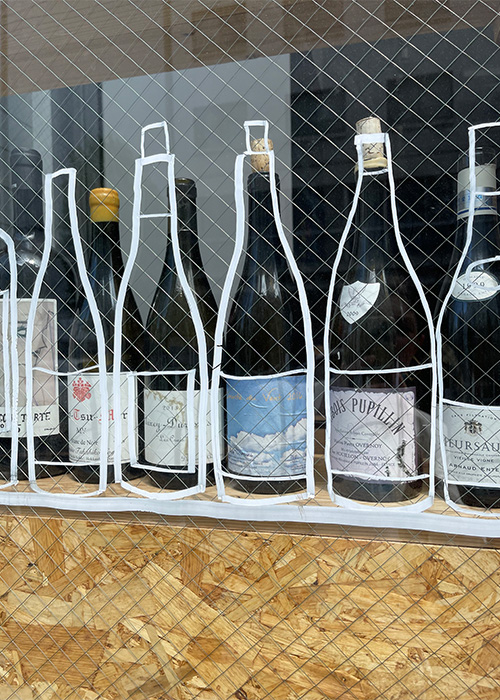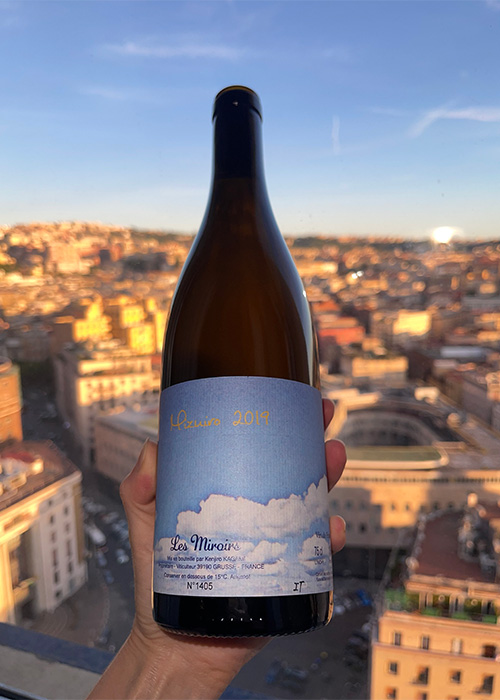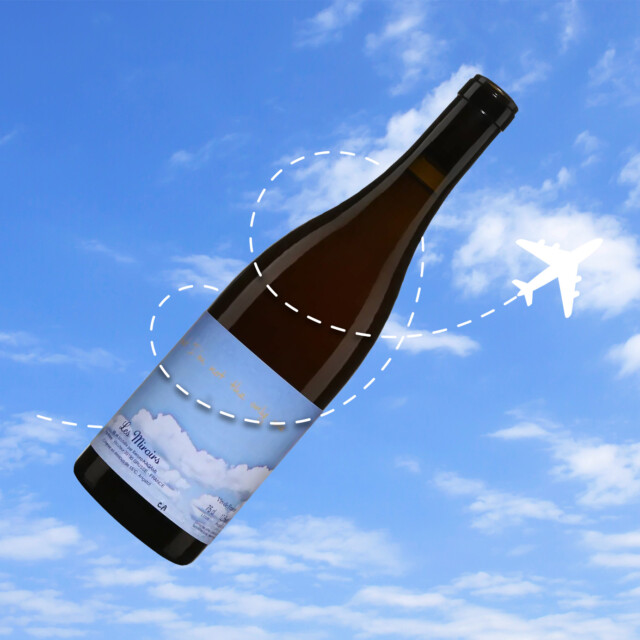While reaching for another bite of the addictive salt and pepper tofu at Chinatown’s Tolo, a bottle perched on a shelf in the back caught the corner of my eye. The familiar light blue label was that of Domaine des Miroirs, a wine from France’s Jura region that’s notoriously difficult to find.
I had seen this wine on display before. I remembered a singular light blue label peeking out from behind the curtain in the window of the now closed Gem Wine Bar. The bottle featured a whimsical scene of swirly white clouds rolling through the sky with curly, almost cursive letters floating along the bottom. And once I noticed it, I couldn’t help but see the wine everywhere — always empty, and never for sale, at least not to the average customer walking by.
I sent a photo to my friend Jackie, a flight attendant and avid wine drinker based in New York City, and she admitted she’d also clocked these Easter eggs hiding in bars and bottle shops, and not only in the U.S. She spotted the mesmerizing bottle in the windowsills of Tokyo’s best retailers and in corners of Paris’s dimly lit wine bars, coyly poking out as a nod to in-the-know patrons.
Other than its prominent placement in highly regarded wine haunts, there’s nothing on the bottle itself that would let on how special it is: The label features minimal text in a small font; there’s no mention of any widely recognized appellation like Gevrey-Chambertain or Hermitage; and the estate doesn’t have centuries of history behind it — the winemaker produced the first vintage just over a decade ago. So what about this bottle has inspired so many professionals to show it off like a trophy?
After observing a few bottles in the wild herself, Jackie decided to research the mysterious wine. And over a string of Instagram DMs egging each other on, we decided we needed to find a way to get our hands on a bottle.
As a flight attendant, Jackie is particularly well suited for this pursuit. Her work schedule often overlaps with the world’s greatest natural wine destinations, with Paris, Nice, Barcelona, Milan, Tokyo, and Lisbon among the most frequent stops. (Though the wine is available in the U.S., a quick Google search will reveal your options start at around $1,000, so international shops seemed to be the way to go.)
We figured it might take some digging to procure the bottle, but neither of us could have predicted the series of strange, cagey interactions that awaited. Jackie’s hunt to try Domaine des Miroirs spanned two years, over 10 cities, and countless wine shops, just to find and purchase one bottle of the cult wine at a (somewhat) reasonable price.
The Lore of Miroirs
The story of Domaine des Miroirs starts with its founder, Kenjiro Kagami, a Japanese native who famously left his job as an engineer for Hitachi to pursue his interest in wine. He took the leap and moved to France in 2001, and after picking up some of the language he enrolled in Burgundy’s Lycée Viticole de Beaune to study winemaking. While in school, he apprenticed at the esteemed Domaine Comte Georges de Vogüé in Chambolle‑Musigny. And in the years following he trained with several more prestigious winemakers across the country, including Thierry Allemand in Cornas and Alsace’s Bruno Schueller.
In 2010, Kagami moved to the Jura to work for the legendary Jean-François Ganevat and the pair instantly hit it off. Ganevat took Kagami under his wing, so much so that when Ganevat discovered a plot of land available in the nearby village of Grusse, he helped Kagami acquire it, marking the beginnings of Domaine des Miroirs. Kagami crafted the winery’s first vintage from this idyllic, steep-sloped vineyard in 2011.
Though working for producers with serious natural wine pedigree helped draw attention to this project, the rabid demand for Kagami’s wines today has outpaced most of his mentors. The reason behind the domaine’s meteoric rise to cult status confounds many wine pros, but some have a few theories.
“Every time I had a layover in a new city I would check out the area’s best wine bars on Instagram to look for pictures of the bottle.”
“Kenjiro Kagami is the primary reason why these wines are sought after,” Nikita Malhotra, beverage director and partner at Smithereens, reasons. “His story is mythical: an engineer who gives up his career and moves to France to learn how to make wine. It’s romantic and passionate, and that he found his way from Burgundy to Jura, that Ganevat helped him find what would become his vineyards, adds texture and layers to the story.”
Another element is Kagami’s roots in Japan, a country often revered for its craftsmanship. Sommeliers have recently drummed up a notable level of excitement around the several Japanese winemakers in France — from Osamu Uchida in Bordeaux to Tomoko Kuriyama of Burgundy’s Chanterêves. “There is the mythos of the Japanese expat quietly crafting low- intervention wine in France,” says Ellis Srubas-Giammanco, wine director at New York City’s Penny. “People seem to be allured by the Japanese sensibilities of aesthetics, ethics, and artisanship when combined with the history and heritage of viticulture in France.”
Kagami’s location in the Jura might also be a story of being in the right place at the right time. When he moved to the Jura, though it was a historic and locally beloved region, it had yet to be widely discovered or appreciated for its peculiarities. But alongside the establishment of Miroirs in the early 2010s, the Jura’s vibrant, savory whites and bright, light-footed reds took the natural wine world by storm.
“When Kenjiro settled in the Jura 15 years ago, the wine world had yet to turn its attention on this place, at least not to the magnitude it does today,” Srubas-Giammanco says. “After gaining experience in Burgundy, the Rhône, and Alsace, he chose to settle in a place where even the region’s best-loved wines were a niche curiosity, a far cry from the monied reality of Burgundy’s hallowed slopes.”
Hide and Seek
Though impossible to put a finger on exactly why these wines hit it big, anyone looking to buy a bottle (any bottle, not just the top cuvée) from Domaine des Miroirs for under $500 will soon discover that the producer’s elusiveness is no joke.
This was the case for Jackie when she started her expedition. She quickly developed a process for how to approach each potential Miroirs-yielding opportunity. “Every time I had a layover in a new city I would check out the area’s best wine bars on Instagram to look for pictures of the bottle,” she says. Then she would message them to inquire about availability.

While many shops felt comfortable boasting about their allocation online, only a few were as open when it came to talking money. When Jackie would reach out to the shops, those that responded would share the wine was already sold out or give a vague answer regarding price: “a few hundred $,” one replied.
Jean-Baptiste Humbert, owner of popular Manhattan retailer Wine Therapy, can attest to the frantic response that ensues after sharing a photo of the wines online. After the shop posted that it had an (undisclosed number) of bottles available (for purchase in-store only) earlier this year, Humbert recalls an onslaught of DMs and eager customers quickly dropping everything to appear at Wine Therapy’s door. “People were showing up in Ubers unannounced,” he says. “They sold out right away.”
Undeterred by the constant dead ends, Jackie continued searching wherever she landed: in small towns across the south of France; in seemingly obscure bars in Frankfurt, Germany; in Japanese retail shops from Sapporo to Osaka; and even in Seoul, South Korea.
In September, Jackie was scheduled to work a trip to Naples, Italy — a new destination for her — and immediately got to work DMing the local natural wine shops. She quickly came across one that had a bottle lineup shot featuring Miroirs pinned to the top of its page (almost too easy). She drafted a message in Italian to inquire about the wines and finally got the response that she had long hoped for. They had two cuvées in stock, each for €350 (~$408).
“The main moral quandary for wholesalers, retailers, and restaurants is that openly selling the wine at a traditional market puts it at risk for being snatched up by those looking to turn a profit online.”
We squealed to each other over text with intense anticipation of the pickup from the wine store the next day. When Jackie arrived, the bottle was tagged for €500, but once she showed them the messages that promised €350, they kept to their word. Thrilled to finally have a bottle in hand — the 2019 Mizuiro Chardonnay, specifically — Jackie took photos of the bottle around the city and thanked the wine shop owner in their message thread.
The shop responded, asking if she planned on posting the wine or tagging them in any photos and Jackie said that she likely would. But when she went to check the messages again, the shop had blocked her.
Joining the Cult
Jackie isn’t alone in her onerous quest to secure a slice of the Miroirs pie. Another curious wine drinker, Wonji (of the Instagram page @fine.vining) had Domaine des Miroirs on a list of wines to seek out while traveling in Europe for over two years before coming across one. When looking up wine lists in Nice, she finally found it on a menu, with the price written as “ask about it.” When she showed up at the shop, it was available at a good price, but only to consume on site — a common occurrence with unicorn bottles as a precaution to keep them off the secondary market.
Malhotra of Smithereens recalls negotiating a mutually beneficial trade at a La Paulée dinner, bargaining a tasting of Domaine de la Romanée-Conti (DRC) for a bottle of Miroirs. “I cradled the bottle and brought it back to the room of sommeliers where we all ogled at it,” she remembers.

Miroirs represents a new wave of cult wines. While producers like DRC slowly built up demand over centuries of history, the fervor for Kagami’s wines is a peek into how the industry is evolving along with new developments like social media. Kagami’s compelling story and low volume of production no doubt contribute to the wine’s status, but the entrancing blue label that pops up on Instagram feeds might also have something to do with it.
“The unfortunate truth is that the secondary market gets fueled by this tactic nonetheless. Consumers experience a paradox of the wine being seemingly everywhere and nowhere at once.”
“Instagram posts as early as 2015 start to document consumption of Miroirs through the ever-present ‘bottle shot.’ Sandwiched between bottles of Raveneau, Clos Rougeard, and Ganevat, onlookers inevitably wondered who the blue-hued newcomer was among such venerated company,” Srubas-Giammanco says. “The problem was acting on that curiosity, which proved a dead end due to the seemingly unparalleled scarcity of the wines.”
The wholesale price for Domaine des Miroirs would suggest it’s actually an affordable wine, available for a fraction of what top grand cru Burgundy would sell for, but the intense social media hype and ever-climbing prices on the secondary market created a feedback loop further driving demand.
“The main moral quandary for wholesalers, retailers, and restaurants is that openly selling the wine at a traditional market puts it at risk for being snatched up by those looking to turn a profit online. There is a justified impetus to ‘protect’ the wine from speculation on the secondary market, so many choose to withhold their allocations, offering them in small amounts to trusted, loyal clients,” Srubas-Giammanco adds. “The unfortunate truth is that the secondary market gets fueled by this tactic nonetheless. Consumers experience a paradox of the wine being seemingly everywhere and nowhere at once, and certain individuals will elect to pay as high a price as necessary to find it.”
For some people, the chase is the whole appeal. “The fact that I couldn’t find it made me want to taste it even more,” Jackie says. And looking back on the two-year ordeal, she would say it was absolutely worth it.
